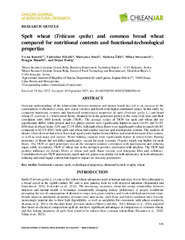Приказ основних података о документу
Spelt wheat (Triticum spelta) and common bread wheat compared for nutritional contents and functional-technological properties
| dc.creator | Kandić, Vesna | |
| dc.creator | Nikolić, Valentina | |
| dc.creator | Simić, Marijana | |
| dc.creator | Žilić, Slađana | |
| dc.creator | Stevanović, Milan | |
| dc.creator | Mandić, Dragan | |
| dc.creator | Dodig, Dejan | |
| dc.date.accessioned | 2023-10-13T12:14:54Z | |
| dc.date.available | 2023-10-13T12:14:54Z | |
| dc.date.issued | 2023 | |
| dc.identifier.issn | 0718-5839 | |
| dc.identifier.uri | http://rik.mrizp.rs/handle/123456789/1175 | |
| dc.description.abstract | Growing understanding of the relationship between nutrition and human health has led to an increase in the consumption of alternative crops, new cereal varieties and foods with higher nutritional values. In this study we compared nutritional contents and functional-technological properties of spelt (Triticum spelta L.) and bread wheat (T. aestivum L.) whole-meal flours, obtained from the genotypes grown at the same field trial, and their correlation with 1000 kernels weight (TKW). The average values of TKW for spelt and wheat did not significantly differ, while protein and wet gluten content were significantly higher in spelt (18.8% and 53.9% DM) than in wheat flours (12% and 27.3% DM). Although wheat flours were significantly richer in starch (66.4% compared to 62.5% DM), both spelt and wheat had similar amylose and amylopectin content. The analysis of dietary fibers showed that wheat flours had significantly higher hemicellulose and neutral detergent fiber content, as well as total sugar and sucrose. Water holding capacity were significantly higher in wheat flours. Pasting properties of flours did not differ significantly, except for peak viscosity (Vpeak) which was higher for spelt flours. The TKW of spelt genotypes was in the strongest positive correlation with amylopectin and reducing sugar, while in contrary, TKW of wheat was in the strongest positive correlation with amylose. The TKW had positive influence on dietary fibers of wheat and spelt flours (except acid detergent fiber and cellulose). Correlation between TKW and protein, starch and wet gluten was similar for both subspecies. In both subspecies reducing and total sugars content had negative impact on viscosity parameters | sr |
| dc.language.iso | en | sr |
| dc.relation | info:eu-repo/grantAgreement/MESTD/inst-2020/200040/RS// | sr |
| dc.rights | openAccess | sr |
| dc.rights.uri | https://creativecommons.org/licenses/by/4.0/ | |
| dc.source | Chilean Journal of Agricultural Research | sr |
| dc.subject | Nutritional contents | sr |
| dc.subject | spelt | sr |
| dc.subject | technological properties | sr |
| dc.subject | thousand kernels weight | sr |
| dc.subject | wheat | sr |
| dc.title | Spelt wheat (Triticum spelta) and common bread wheat compared for nutritional contents and functional-technological properties | sr |
| dc.type | article | sr |
| dc.rights.license | BY | sr |
| dc.citation.volume | 83 | |
| dc.citation.issue | 1 | |
| dc.citation.spage | 146 | |
| dc.citation.epage | 158 | |
| dc.identifier.doi | 10.4067/S0718-58392023000200146 | |
| dc.identifier.fulltext | http://rik.mrizp.rs/bitstream/id/6249/bitstream_6249.pdf | |
| dc.type.version | publishedVersion | sr |


